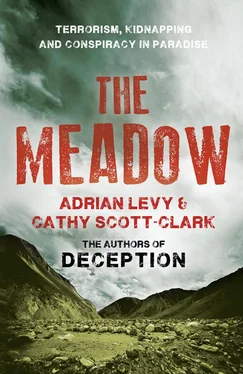The fate of Masood, and the bloodshed and intrigue that engulfed the six Western trekkers, would shape much of the epoch that followed. In the mountains of Kashmir that summer, Masood’s gunmen experimented with the tactics and rhetoric of Islamic terror, unveiling to the world extreme acts and justifications that would soon become all too familiar.
Finding and squeezing Western pressure points, testing foreign governments’ sensibilities and resolve, this hostage-taking would enable Masood and his men to refine their methods before they combined forces with Osama’s al Qaeda, soon assisted by the black-turbanned Taliban when they came to power in Afghanistan in 1996.
It would only be a short leap from the kidnappings in Kashmir to suicidal assaults in Srinagar, New York, Washington and London, in which many thousands would die or be injured. Three months after 9/11, India accused Masood of being behind a brazen raid on its parliament in New Delhi, an assault that was broadcast across the subcontinent, just as the Twin Towers had fallen before a live TV audience around the world.
In 2002, Masood’s bodyguard and one of his British recruits adapted tactics honed during the Kashmir kidnapping to abduct Daniel Pearl, a Wall Street Journal reporter, and to film his horrific beheading. Masood himself, like Osama, slipped from public view, becoming a shadowy éminence grise . In 2004 he welcomed several British Pakistanis back to the land of their forefathers, and in the terrorist training camps of north-west Pakistan he helped them plan for the mayhem they would unleash in London in July 2005, when four near-simultaneous suicide bombs went off in the heart of the heaving capital, killing fifty-two and injuring more than seven hundred.
In 2006, another of Masood’s British protégés manipulated jihadi recruits from the West to mount a complex plot to bring down multiple airliners over the Atlantic with liquid bombs smuggled aboard in soft-drinks bottles. Many more plots in India, the US and the UK were narrowly thwarted, saving untold lives. By the time Osama bin Laden was run to ground in Abbottabad, many others from al Qaeda’s top table had perished too. Apart from Masood Azhar.
He continues to thrive, flitting today between Pakistan’s borders and his old home in Punjab. Four of the tourists seized in Kashmir in the summer of 1995, whose abduction foretold a new age of terror, simply vanished. Their bodies were never found, and their case was forgotten. Until now.
When the book was first published it provoked a storm in India, with the government challenged by national newspapers and cable news networks to respond, New Delhi giving the New York Times a date by when it would. That day came and went. However, lawyers in Kashmir representing the Association of Parents of Disappeared Persons (APDP), an organisation representing some of the estimated 8,000 Valley dwellers who are said to have vanished after being taken into the custody of the Indian security forces, picked up the baton. The organisation filed a petition with the Indian government’s Human Rights Commission in the spring of 2012, alleging that the army and government had deliberately misled the investigation into the kidnappings and withheld information. They also suggested that a criminal network had been formed between the kidnappers and government militiamen that worked together to keep the hostages hidden from view. They demanded the case file be made public and that senior policeman be called in for questioning. On April 17, the commission agreed to review the seventeen-year-old case, triggering headlines around the world, from Fox News in the US to the BBC in London.
By July, the police had declined to react to the judge’s request to produce the Al Faran file, with the Inspector General warned by the commission that action would be taken against him. Finally, on August 13, five months after the case was listed, the J&K police Crime Branch submitted its official response. They claimed that the master file, containing key evidence, ‘went to ashes due to a fire incident’. The case is ongoing but the army and intelligence services are immune from investigation and will escape the probe.
CATHY SCOTT-CLARK AND ADRIAN LEVY
London, April 2013
ONE 1. Packing 2. A Father’s Woes 3. The Meadow 4. Home 5. Kidnap 6. The Night Callers 7. Up and Down 8. Hunting Dogs 9. Deadline 10. Tikoo on the Line 11. Winning the War, Call by Call 12. The Golden Swan 13. Resolution Through Dialogue 14. Ordinary People 15. The Squad 16. The Game 17. The Goldfish Bowl 18. Chor-Chor Mausere Bhai (All Thieves are Cousins) 19. Hunting Bears 20. The Circus Epilogue: Fill Your Arms with Lightning Picture Section Acknowledgements A Note on Sources About the Authors Praise By the Same Authors Copyright About the Publisher
Packing 1. Packing 2. A Father’s Woes 3. The Meadow 4. Home 5. Kidnap 6. The Night Callers 7. Up and Down 8. Hunting Dogs 9. Deadline 10. Tikoo on the Line 11. Winning the War, Call by Call 12. The Golden Swan 13. Resolution Through Dialogue 14. Ordinary People 15. The Squad 16. The Game 17. The Goldfish Bowl 18. Chor-Chor Mausere Bhai (All Thieves are Cousins) 19. Hunting Bears 20. The Circus Epilogue: Fill Your Arms with Lightning Picture Section Acknowledgements A Note on Sources About the Authors Praise By the Same Authors Copyright About the Publisher
They weren’t the type to brag. But Jane Schelly and Don Hutchings had been to many places, far more than most of their friends. Soon after getting together back in 1985, they had concluded that in this life there was no point treading water. With no children between them, Don, forty-two, and Jane, forty, had made the most of their shared wanderlust, embarking on six ambitious foreign expeditions in the past eight years. Now, on a summer’s evening in late June 1995, Jane was packing once again, surveying the items laid out around the bedroom of their large, high-ceilinged cedarwood home in the Pacific north-west, ticking them off on a checklist: money belts, passports, tickets and travellers’ cheques, a well-thumbed edition of the Lonely Planet Trekking in the Indian Himalayas , preparing for their latest foreign foray with the clinical confidence of the well-travelled. Memories flitted back and forth – Switzerland, Bolivia, Turkey, India, Nepal. They lived for the wilds, preferably high up in some mountain range. She loved her job as a physical education teacher at a local elementary school, but Jane lived for these summer voyages.
It was a passion for the outdoors that had thrown her and Don together, and as she got ready for another adventure she found herself thinking how strange it was that they had turned out to be such a perfect fit, as back at the start she had not been at all sure about him, and had not thought there would ever be a them . Nowadays she loved Don’s strong, calm demeanour, this dependable climber with a sinewy frame and a rugged beard, who brought others through risky situations with a joke and a squeeze of the arm.
On their wedding day in 1991, Don described them as climbing partners. ‘When you’re tied to someone with a rope,’ Jane would later say, ‘you get to know them very well, and you learn about trust.’
At home they were sober, law-abiding citizens, from solid backgrounds: her father had been a scoutmaster, his a cattle rancher. Out in the wilds, they were both risk-takers. Don had hacked up Mount McKinley in Alaska and taken a tumble at Montana’s Rainbow Falls. Jane had traversed the volcanic glacier fields of Mount Rainier and taught cross-country skiing at Spokane Falls Community College. On a clear day, Rainier, the highest peak in the Cascade Range, was just about visible west of Spokane, a laid-back, outdoorsy sort of city on the eastern fringes of Washington state, where the couple lived and worked. ‘The Mountain’, as people called Rainier, with its three peaks, Columbia Crest, Point Success and Liberty Cap, served as a constant reminder of why they were there. ‘Mount Rainier had a special meaning for him,’ said Jane. Don had been brought up in Spokane, whose motto was ‘Near Nature, Near Perfect’, and the mountains, lakes and woods grounded him like no other place, he said.
Читать дальше











